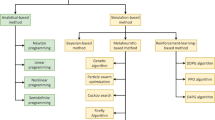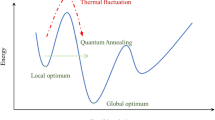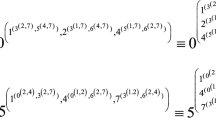Conclusions
The analytic relationships derived in this paper could be used in practice to set forth the estimated requirements to the characteristics and the choice of the components of elementary (consecutive) computational systems of different complexity level and different purposes (computers, computer units, and programs). Proceeding from overall system requirements, these relationships can be used after the set of system components has been determined. This principle should also be applied to a different organization of the computational process according to classification of [1]. Other methods of structural optimization could also be used to arrive at more accurate estimates of the realization complexity. For instance, when building an arithmetic logic device (ALD), one could proceed, after solving one of the problems discussed here (for instance, the first problem), to use the results of [10] to optimize the bus-register structure of ALD.
Similar content being viewed by others
Literature Cited
M. T. Flynn, “Some computer organizations and their effectiveness,” IEEE Trans. Comput.,21, 948–960.
B. S. Sotskov, Principles of the Theory and Calculation of Reliability of Automation and Computer Components and Devices [in Russian], Vysshaya Shkola, Moscow (1970).
Yu. S. Golubev-Novozhilov, Multicomputer Complexes [in Russian], Sov. Radio, Moscow (1967).
Yu. P. Zhuravlev, System Design of Control Computers [in Russian], Sov. Radio, Moscow (1974).
V. L. Volkovich and L. F. Dargeiko, “An algorithm for selection of a compromise solution for linear criteria,” Kibernetika, No. 5, 62–69 (1972).
G. Korn and T. Korn, Mathematical Handbook for Scientists and Engineers, 2nd ed., McGraw-Hill, New York (1967).
H. R. Grosch, “High-speed arithmetic: the digital computer as a research tool,” J. Opt. Soc. Amer.,43, No. 4, 306–310 (1953).
Knight, “Evaluation of the development of computer features,” Zarub. Radioelektronika, No. 11, 63–83 (1968).
D. Ferrari, Evaluating the Performance of Computers [Russian translation], Mir, Moscow (1981).
E. P. Bashlakov, A. F. Kurgaev, and A. V. Palgin, “Synthesis of the structure of the operational automaton of a microprocessor,” Kibernetika, No. 3, 138–142 (1980).
Additional information
Translated from Kibernetika, No. 6, pp. 49–56, November–December, 1984.
Rights and permissions
About this article
Cite this article
Kurgaev, A.F. Analytic estimates of computer design at the structural stage. Cybern Syst Anal 20, 829–840 (1984). https://doi.org/10.1007/BF01072170
Received:
Issue Date:
DOI: https://doi.org/10.1007/BF01072170




